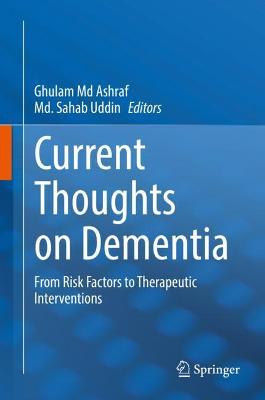(To see other currencies, click on price)
MORE ABOUT THIS BOOK
Main description:
This informative book discusses the latest research on the risk factors and therapeutics in dementia. WHO calls dementia a public health priority. Dementia manifests as a group of symptoms associated with decline in memory or other thinking skills and is severe enough to reduce a person's ability to perform everyday activities. It occurs frequently among elderly people, but it is not necessarily part of the normal aging process. The book has been divided into two broad sections. The first section reviews the risk factors involved in developing dementia, including various medical conditions, lifestyle choices, as well as genetics. The latter section describes various therapeutic interventions in dementia. Although there is no known cure for dementia, this book underlines the current treatment strategies that could momentarily reduce the symptoms and improve the quality of life of the patients. This book highlights the global effort to find better ways to halt the progression of dementia and develop novel therapeutic strategies.
The book would be an interesting read for advanced graduate students and researchers working in the field of neuroscience, genetics, and medicine. It will generate good interest to neurologists, psychiatrists, geriatricians, cardiologists, internal medicine practitioners, epidemiologist, and public health workers.
Contents:
Risk Factors
Apolipoprotein E (APOE)
Histone modifications, demethylation, and microRNA regulation
Triggering receptor expressed on myeloid cells 2 (TREM2)
Brain-derived neurotrophic factor (BDNF)
Bridging integrator 1 (BIN1)
Protein tyrosine phosphatase 1B (PTP1B)
Leptin signaling
Insulin signaling
Autophagic dysfunction
Ubiquitin-proteasome system dysfunction
Circadian dysfunction
Endoplasmic Reticulum Stress
Depression
Normal pressure hydrocephalus
Antiphospholipid antibodies
Sex hormones
Changes in blood factors
Infection-induced systemic inflammation
Microbiota
Abdominal visceral fat
Atypical microvascular morphology
Plasma exosomes spread
Changes in visual cortex
Obesity, dyslipidemia, hyperglycemia and hypertension
Environmental pollutions
Therapeutic Interventions
NMDA receptor antagonists
Calcium channel blockers
Catecholamine
Statins
Immunotherapy
Quitting smoking
Physical activity
Diet and nutrition
Natural products as promising drug candidates
Nanotechnological applications
Electroacupuncture
Repetitive transcranial magnetic stimulation
Transcranial direct current stimulation
Reminiscence therapy
Reality orientation therapy
Bright-light therapy
Snoezelen multi-sensory stimulation
Behavioral therapy
Brain-computer interface applications
Music therapy
Hypoxic-hyperoxic training
Cognitive rehabilitation
Cognitive creativity
Stem cell research
PRODUCT DETAILS
Publisher: Springer (Springer Verlag, Singapore)
Publication date: July, 2022
Pages: None
Weight: 1118g
Availability: Available
Subcategories: Biomedical Engineering, Genetics, Neurology, Neuroscience

